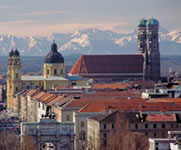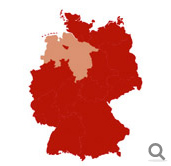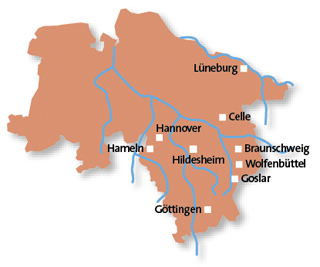.jpg)
Historical Towns
- Historical towns in Brandenburg
- Cathedral Towns and Cities in Saxony-Anhalt
- The innovative Anhalt-Wittenberg Region
- Enchanting towns in the Harz
- The beautiful towns and cities in Saxony
- Towns and cities of culture in Thuringia
- Beautiful towns of Franconia
- East Bavarian traditional towns
- Alpine towns in the Allg�u
- The eastern Akpine Foothills and their towns
- Towns and villages in the western foothills of the Alps
- Mediterranean towns on Lake Constance
- Towns in the Swabian Alb
- Unspoilt towns in the Black Forest
- Towns for refined tastes in the Heilbronner Land
- Towns in the Odenwald
- Wine towns in Rheinhessen
- Saarland, a region of contrasts
- Romantic towns in the Hunsr�ck and Nahe Regions
- Idyllic towns and villages in the Moselle Region
- The Ahr Rhine Eifel holiday region
- Wine towns on the Romantic Rhine
- Modern towns and cities in the Bergisches Land Region
- The Lahn Valley and its fairytale towns
- Historical towns in Kurhessisches Bergland
- Sauerland's scenic towns
- Fairytale towns in the Weserbergland Hills
- Majestic towns in the M�nsterland Region
- The nine stars of Lower Saxony
- North and East Frisian Islands
- Vibrant Schleswig-Holstein
- Maritime towns along Mecklenburg's Baltic Coast
- Historical Hanseatic Towns
- Germany's Baltic Sea Islands
- The Mecklenburg Lakes
Contact and information
On cloud nine in northern Germany nine great locations and one famous fairytale
.jpg)
Hannover
The history of Hannover's ruling dynasties is closely linked with that of the British monarchy. Elector Georg Ludwig, who ascended the British throne as George I, reigned over Great Britain and Hannover together. Only when Prussia intervened in 1807 did Hannover become part of the Kingdom of Westphalia. Baroque Herrenhausen Gardens, one of Europe's finest parks, and a gilded carriage in the Historical Museum bear witness to the city's distinguished past. Today Hannover enjoys international renown as a venue for trade fairs, most notably the CeBIT for computers and IT.Braunschweig
Braunschweig was the seat of Henry the Lion, the mighty imperial prince of the 12th century, and his son Otto IV, the House of Guelph's only emperor. The heart of Braunschweig is encircled by the Oker river, which once formed part of the town fortifications. Sightseeing rafts go almost full circle around this delightful centre, passing beautiful parks and mansions. The Duke Anton Ulrich Museum, which was founded by the Guelph dynasty, is the world's second-oldest public museum.Wolfenbüttel
The most distinctive features of Wolfenbüttel are its precisely arranged Renaissance centre, its royal palace and the timberframed houses that number well over 600. Today Wolfenbüttel is a major centre of culture in Lower Saxony. The town's Duke August Library contains the famous Gospels of Henry the Lion, once the most expensive book in the world. Gotthold Ephraim Lessing was born in Wolfenbüttel. Casanova, on the other hand, may have only stayed briefly, but literature's most famous philanderer described his time in the town as the best weeks of his life.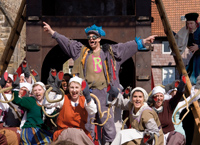
Hamelin
Hamelin in the Weserbergland hills owes its worldwide fame to a legend that originates from the Middle Ages. So the story goes, a travelling minstrel lured a plague of rats out of Hamelin, followed by the town's children who were never to be seen again. Reminders of the tale can be found all over the town. Among its most prominent monuments are the Pied Piper museum, the Pied Piper house, the fountain on the town hall square and the stained-glass windows of the market church.Lüneburg
Salt, or `white gold' as it was known, brought fame and fortune to Lüneburg during the Middle Ages. The prosperity enjoyed by this former Hanseatic power with its 1,050-year history is reflected in the magnificent patrician houses with their distinctive gables and the medieval town hall, the largest of its period in Germany. Brick Gothic architecture and a fully intact medieval ensemble strike a captivating contrast to the lively atmosphere of this university town. Salt continues to play an important role in Lüneburg, for example at the German Salt Museum and the SaLü thermal baths.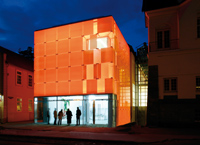
Celle
The former ducal town of Celle lies on the southern edge of the Lüneburg Heath. The old quarter is particularly attractive with more than 450 timber-framed houses under historical protection. Most were built between the 16th and 18th centuries. The Residenz Museum and the crypt where the Guelph princes were buried provide detailed information about the town's history. Celle Art Museum, the world's first 24-hour museum, offers a true avant garde experience.Goslar
Glorious countryside surrounds Goslar, which enjoyed free imperial status during the Middle Ages. Churches, mighty towers and colourful half-timbered houses dominate the town, whose wealth derived from centuries of silver mining. Among the earliest visitors to Goslar were the kings and emperors who gathered in the town for imperial diets in the 12th century.Hildesheim
Hildesheim is renowned for its churches and cultural monuments. St. Mary's Cathedral and St. Michael's Church are masterpieces of religious architecture that comprise a joint UNESCO World Heritage site. The town's historical market square also merits attention. Its centrepiece is the famous Butchers' Guild Hall.Göttingen
Göttingen's Georg August University has given the world more than 40 Nobel Prize winners. Göttingen, whose people were among the first to wrest civil rights from the ruling classes, is a popular student town with a buzzing cultural scene and nightlife. Its pride and joy is the fountain of the Goose Girl, who is said to be the most kissed girl in the world. Tradition dictates that every doctoral student has to kiss the statue on the day they receive their doctorate.Travel Planner
Select an option...
Romance and charm
The enchanting Christmas forest in Goslar is an eagerly awaited festive attraction. Illuminated by thousands upon thousands of lights, the town centre wood heightens the anticipation for Christmas against the medieval backdrop of the old quarter.
Food and drink
The Stintmarkt promenade offers culinary delights and a laid-back atmosphere in the historical surroundings of Lüneburg harbour. Here you can enjoy picturesque views of the water from the popular stint terraces.
History and tradition
Guided tours of Hildesheim roll back the centuries to times long past. Entertaining tour guides in lavish costumes whether it's the witch, the draper or the Mayor and his wife regale you with lots of information about the town and its history.
Nature and scenery
Riddagshausen conservation area and European reserve lies north of the Braunschweig district of the same name. Cistercian monks laid out the ponds as a fish farm over 900 years ago and the area is now home to a wide range of flora and fauna.




